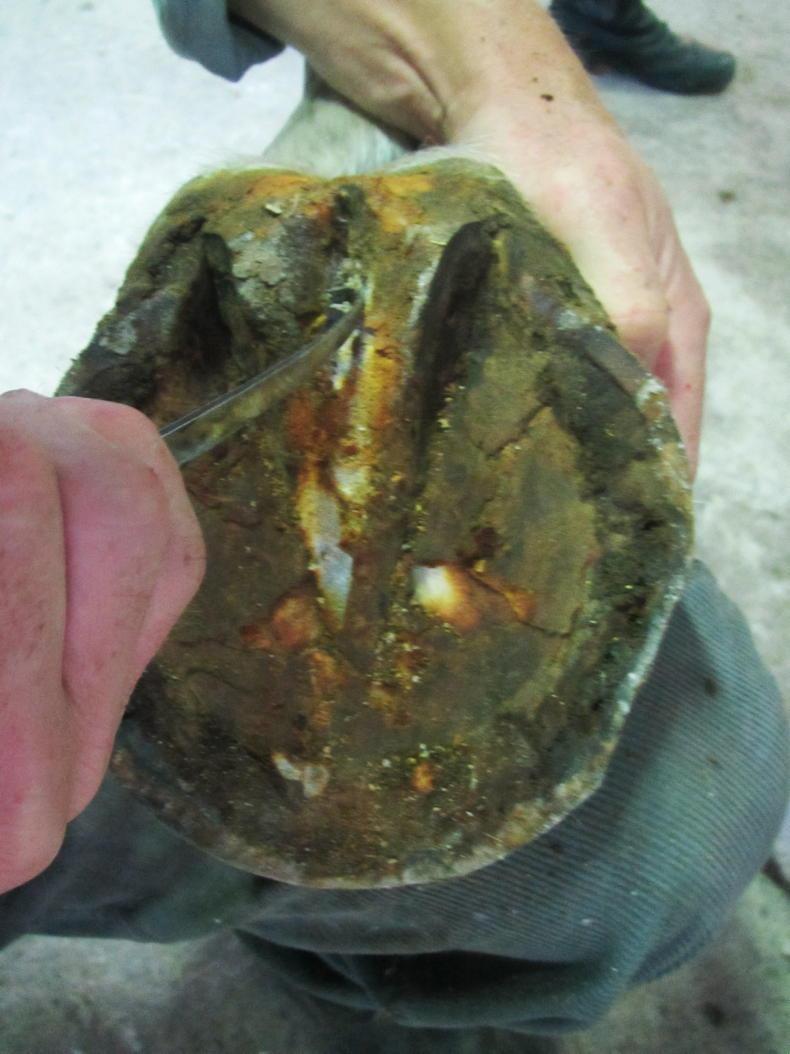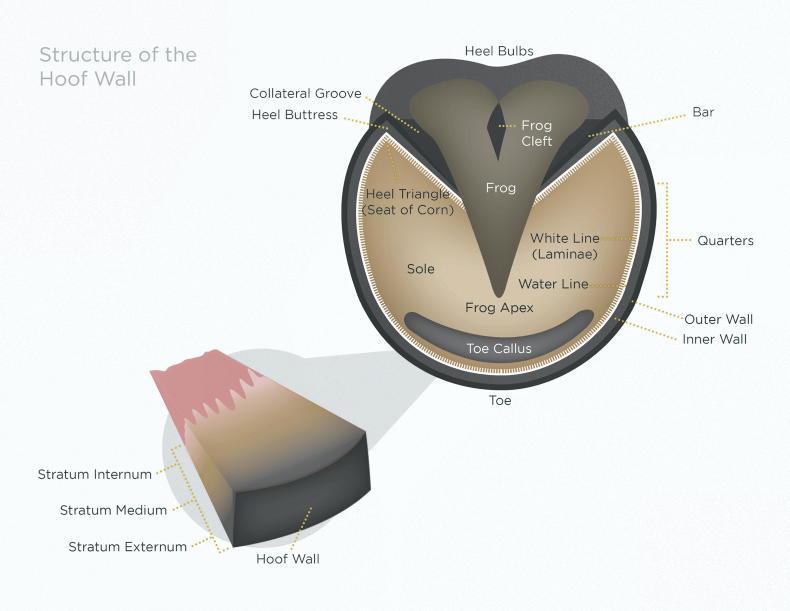What is thrush?
Thrush is an infection which causes degeneration of the frog of the horse’s feet. The central and lateral grooves of the frog become softened and subsequently damaged.Thrush is the equine equivalent of athlete’s foot in humans. A healthy frog has a regular outline and is smooth, while a thrushy frog is soft, pitted and irregular.What causes thrush?
It is caused by an anaerobic organism named Fusiformis Necrophoris (same as the sheep foot rot organism), which thrives in most moist environments. An anaerobic organism can survive without oxygen. Keratonolytic (keratin-loving) bacteria can attack the softened tissues of the frog causing it to rot away.These damaged areas multiply and increase when the frog area becomes under-run.What are the usual predisposing factors in thrush?
Inadequate or poor standards in:
Stable management.Conformation. Farriery or the lack of it.Stable management
Poor stable management: The primary cause is considered to be poor hygiene which can cause thrush to flourish. For example unhygienic environmental conditions which require the animal to stand in mud, urine-soaked or faeces-soaked bedding, is one of the main causes.
The frog is made from soft horn and is susceptible to penetration by bacteria especially when stabled horses are left standing in wet and dirty bedding. The invasive organisms that cause thrush thrive in moist conditions. They burrow through the horn and can cause irritation of the underlying sensitive tissues.However, while stabling a horse for prolonged periods in foul, underfoot conditions can cause thrush, some horses kept in these conditions are unaffected, while others in perfect accommodation can develop thrush.The individual susceptibility of the horse seems to be a major factor.When thrush is confined to the frog it rarely causes lameness, but once the deeper tissues are affected, intermittent tenderness can result.Turnout on constantly damp, swampy or marshy pasture may also cause thrush.Conformation – poor foot conformation (especially of the frog)
Hoof and frog conformation play a significant role in a horse’s susceptibility to thrush. Long, forward-sloping heels tend to encourage the central frog cleft to deepen and continue into the bulbs of the heel. This area can then get packed with debris, leading to inflammation and infection. Therefore some horses are more susceptible to this condition, as their foot conformation can lead to a predisposition to thrush.For example, a deep cleft in the frog may become packed with sand after working in an arena. If not carefully cleaned, this could lead to irritation and allow bacteria to enter.Long narrow feet, prone to contracted heels, with associated small, narrow frog and compressed involuted central groove.Sheared heels, where a gap develops between the bulbs of the heels due to a chronic foot imbalance.An acquired frog deformity, perhaps as the result of an injury.Farriery
Poor foot care: Failure to clean out the hooves regularly. This is one of the commonest causes of thrush. If not cleaned out regularly the hoof does not get the opportunity to dry and remains moist, making perfect conditions for thrush to develop.Poor or incorrect foot trimming/ shoeing: Lack of frog pressure due to bad shoeing or poor standards of foot trimming (e.g. sheared heels). Shoeing with full pads, allowing dirt and moisture to collect and fester.A badly shaped shoe, nailed too far back, can prevent expansion and contraction of the heels, leading to shrinkage and possible “rotting away” of the frog. A badly fitting frog plate of a heart-bar shoe can damage the frog, leading to infection.
Is thrush a painful condition?
Despite the very strong nasty smell and discharge, the horse often appears completely unperturbed by the problem, with no apparent discomfort or lameness evident.However, pain and lameness can occur in some more serious long-standing cases.This occurs where the infection is severe and it can under-run the adjacent sole and spread to involve the deeper structures, such as the digital cushion, hoof wall and heel bulb.Then there may be some pain on palpation around the frog and bulbs of the heel, together with filling of the limbs and a varying degree of unsoundness. This is due to infection getting into the deeper tissues and then travelling up the horse’s leg.
What are the symptoms of thrush?
The most obvious signs of thrush is the foul smelling black discharge from the lateral and central clefts of the frog which itself may have softer spots and appear irregular in shape.The hind feet are more commonly affected but perhaps this is because the hind feet are not cleaned out as regularly or as often as the front feet.The horse may show lameness. In some cases the cleft of the frog be comes deeply under-run and infection gets into the sensitive laminae.When the central cleft of the frog splits, the infection proliferates and either on its own account or along with the independent medial and later movement at the back of the foot, pain and lameness result.What treatments are used for thrush?
Daily management has a significant role to play in the prevention and treatment of thrush.If a horse has thrush, the underlying cause should first be identified and removed.The horse should be moved to a clean, dry environment and the feet cleaned daily.The feet should be picked out daily and susceptible horses that are stabled during the day should stand on clean, dry concrete or matting to allow air to get to the feet.Regular turnout on a dry paddock is also beneficial.Every vet has her/his favourite remedy, most of which aim to dry out the feet. The veterinary advice and treatment procedure will include the following:Thrush will never resolve unless the hoof hygiene is good. A damaged frog is the perfect entry point for the bacteria that cause tetanus, so the treating vet will ensure that the horse has adequate protection against this risk.The initial stage of treatment is to remove all of the decayed dead tissue from the infected area using a hoof knife on at least one occasion, until healthy tissue is reached. This may need to be done over more than one visit depending on the severity of the condition. Once the diseased tissue is removed, the area is washed with a disinfectant and dried thoroughly.Applications such as Stockholm tar, hydrogen peroxide, eucalyptus oil etc, may be used. There are also a multitude of formalin-based products which can be applied.An antibiotic spray will be prescribed to apply to the affected parts of the feet after they have been completely dried. This procedure needs to be repeated twice daily until the infection has disappeared.Bedding should preferably be either paper or shavings.If the horse is turned out, it should only be on a well draining paddock or it should be brought in to stand on a dry surface for several hours each day.A course of systemic antibiotics may be prescribed in some cases if the infection has spread or travelled up the leg.Alternatively the treating vet may opt to use other treatments instead of using antibiotics. This may be one of the following:- An Iodine solution
- Copper Sulphate or Blue Stone
- Formalin 10% solution
- Chlorine bleach
- Povidine
- It is important to note that the application of any of these products must be restricted to the sole and the frog areas and not applied over the coronary band nor on the pastern area. Products such as copper sulphate could cause damage to healthy skin in the latter areas.
- When infection has entered the sensitive laminae, the treating vet will recommend that a poultice should be applied to the foot. A course of antibiotics will usually be prescribed in these cases.
- A bar shoe may be recommended to minimise movement. However, the bars may present a risk of impeding the air from circulating into the frog. Occasionally, where a bar type shoe is considered as part of the essential treatment process, the vet may recommend a specially welded shoe with a raised bar across the toe and heel. This type of shoe allows air to circulate under the foot.
- Some vets recommend lowering of the hoof wall to increase the frog pressure. It is important to ensure that the normal angle of the foot is not altered and also to ensure that the horse is still on a clean dry surface.
How is thrush prevented?
- Careful stable and hoof management is essential if thrush is to be prevented.
- As the bacteria are killed by oxygen, regular use of the hoof pick will allow air to access the foot and reduce the ability of the bacteria to take hold.
- Keeping stables clean with plenty of good quality, dry bedding. If horses are in for long periods, bank the beds during the day to allow them to stand on an area of clean, dry concrete.
- Bedding such as wood shavings or paper, both of which drain down to the base leaving a dry top layer, may be fairly good options.
- Routine regular farriery is important. To ensure that the frog pressure is maintained, regular foot trimming and shoeing should be carried out by a competent farrier.
- If outdoors, a dry paddock should be used if possible.
What is the prognosis?
- Symptoms respond well to treatment but this involves a lot of hard work as on-going daily attention is required for quite a while which could extend over several months.
- In addition to treatment, thrush problems should be relatively easy to resolve if management is improved. However unless the hoof hygiene is good, the condition will not be cleared fully. As previously mentioned, a damaged frog is the perfect entry point for the bacteria that cause tetanus, so adequate protection against this occurring must be put in place. If the condition persists and lingers even after treatment, management should be reviewed to consider whether it could be the more serious condition of canker. Draught horses are more high-risk canker candidates.




 This is a subscriber-only article
This is a subscriber-only article
 It looks like you're browsing in private mode
It looks like you're browsing in private mode











SHARING OPTIONS: